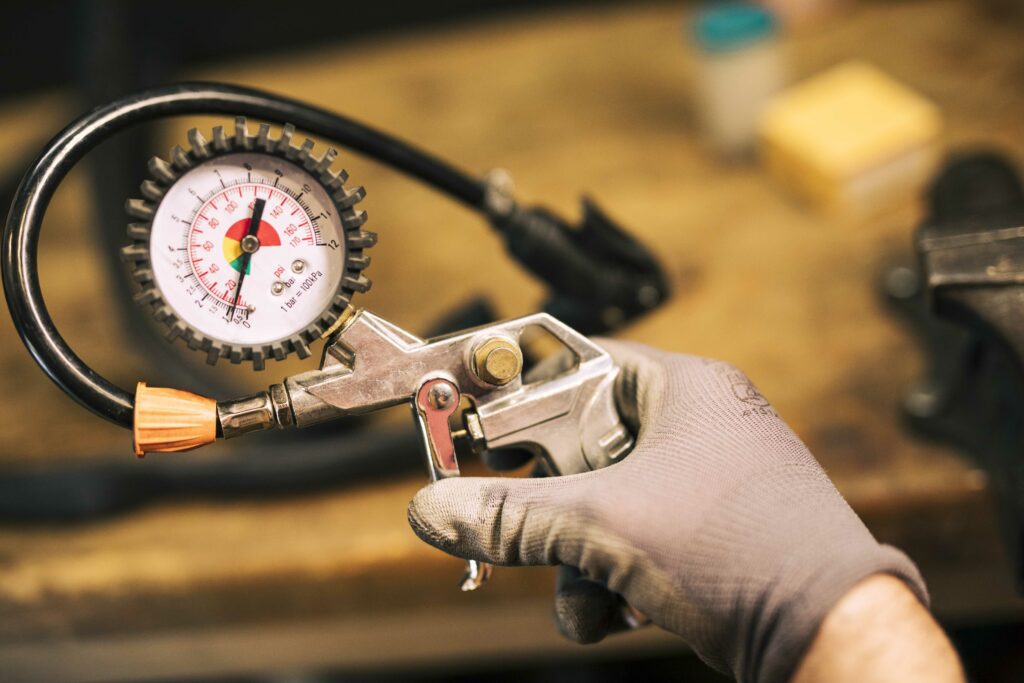The heart of your vehicle, the engine, relies on an intricate balance of elements to function optimally. One critical component that plays a significant role in maintaining this balance is the “oil pressure gauge”. This seemingly small device is a powerhouse of information, helping keep your engine healthy and efficient. Understanding how an oil pressure gauge works can save you from expensive repairs and unexpected breakdowns.
The Basics of Oil Pressure Gauges
At its core, an oil pressure gauge is a device designed to monitor the oil pressure within your engine. It comprises three main components:
- Sensor. The sensor detects the oil pressure. The sensor is typically located near the oil filter and directly measures the oil pressure. Depending on the type of gauge, the sensor may be either mechanical, using a tube to transmit pressure to the gauge, or electrical, sending an electronic signal to the gauge.
- Gauge face. The gauge face displays the reading. The gauge face is the part of the oil pressure gauge that you see on your dashboard. It displays the oil pressure reading in psi (pounds per square inch) or bar.
- Needle. The needle, moving over the gauge face, indicates the current oil pressure.
Accurate oil pressure readings are crucial for optimal engine performance and longevity. They help ensure that the engine’s moving parts receive adequate lubrication, preventing premature wear and tear.
Mechanics Behind Oil Pressure Gauges
An oil pressure gauge operates on a straightforward principle. It involves a pressure sensor and a mechanical or electrical gauge mechanism. The pressure sensor detects the oil pressure in the engine and converts it into a signal, either physical or electrical. This signal is then interpreted by the gauge mechanism and displayed on the gauge face.
In a mechanical oil pressure gauge, a tube filled with oil connects the sensor to the gauge. When the engine’s oil pressure changes, it directly moves the needle on the gauge via this tube.
On the other hand, an electrical oil pressure gauge uses an electronic sensor and a variable resistor. The sensor, responding to changes in pressure, alters the resistance. This change is then measured and converted into an oil pressure reading by the gauge.
Interpreting Oil Pressure Readings
Interpreting oil pressure readings accurately is crucial in maintaining your engine’s health. The typical range of oil pressure readings varies depending on the engine condition. For instance, at idle speed, the oil pressure might be lower, around 10 to 20 psi. During normal driving conditions, it could range from 20 to 65 psi. Under high RPM, the oil pressure can even reach up to 80 psi.
Monitoring these fluctuations allows you to spot abnormal readings, which could indicate potential problems. These readings can indicate underlying issues that need immediate attention. Understanding what these abnormalities look like can help you take timely action. Here are some key points to keep in mind when monitoring your oil pressure gauge.
- High Pressure: An unusually high oil pressure reading could indicate a blocked oil passage or a faulty relief valve. Continuous high readings are abnormal and should be addressed promptly.
- Low Pressure: If your gauge consistently shows low oil pressure, it may be due to worn-out engine parts, inadequate oil level, or poor oil quality. Such readings can lead to insufficient lubrication and engine damage if not corrected.
- Erratic Readings: Erratic or fluctuating readings can point to issues with the oil pressure sensor or the gauge itself. It might also suggest unstable oil pressure, which requires immediate attention.
- No Reading: A gauge displaying no reading at all could mean a complete sensor failure or a power supply issue. This is a clear indication of an abnormality and requires troubleshooting.
Being able to spot abnormal oil pressure readings is an essential part of maintaining your vehicle’s engine health. By recognizing high pressure, low pressure, erratic readings, or no reading at all as signs of potential issues, you can take proactive measures to address these problems.
Any persistent abnormality in your oil pressure readings warrants professional assessment. Ensuring your oil pressure gauge functions properly is a small step that can make a significant difference in your vehicle’s performance and longevity.
Maintaining Oil Pressure Gauges
Maintaining your vehicle’s oil pressure gauge is an essential part of ensuring your engine operates efficiently and effectively. A well-maintained gauge provides accurate readings, helping you avoid potential engine damage due to insufficient lubrication. Here are some key steps to consider when maintaining your oil pressure gauge.
- Regular Checks: To ensure the accuracy of your oil pressure gauge, carry out regular checks. This will help you notice any irregularities in the readings, which could indicate underlying issues with the gauge or the engine’s oil pressure.
- Calibration: Over time, the oil pressure gauge may need recalibration to continue providing accurate readings. Calibration should be done periodically or whenever you suspect the readings are off.
- Cleanliness: Keeping the gauge clean can prevent dust and debris from interfering with the readings. Use a soft, damp cloth to wipe the gauge face without scratching it.
- Sensor Inspection: The sensor plays a crucial role in detecting oil pressure. Regularly inspect it for signs of wear and tear or damage. If necessary, replace the sensor to ensure the gauge functions correctly.
- Professional Servicing: For comprehensive maintenance, consider having your oil pressure gauge serviced by a professional. They can perform a thorough check, calibration, and cleaning, and they can address any underlying issues that may affect the gauge’s performance.
Maintaining your oil pressure gauge is not just about ensuring accurate readings; it’s about safeguarding the health of your engine. With regular checks, calibration, cleanliness, sensor inspection, and professional servicing, you can keep your gauge in top condition and your engine running smoothly. Remember, preventive maintenance is always better (and often cheaper) than reactive repairs. Keep your oil pressure gauge well-maintained and enjoy a reliable and efficient driving experience.
Troubleshooting Oil Pressure Gauges
Troubleshooting your vehicle’s oil pressure gauge can be a critical step in preventing potential engine damage. By identifying and addressing any issues early, you can ensure the gauge provides accurate readings. Here are some essential steps to consider when troubleshooting your oil pressure gauge.
- Inconsistent Readings: If the gauge displays erratic or inconsistent readings, it could indicate an issue with the oil pressure sensor or the gauge itself. Inspect the sensor for damage and test the gauge’s functionality using a pressure gauge tester.
- Low Oil Pressure Reading: A low oil pressure reading might result from clogged oil passages restricting oil flow. Check the oil level and quality, and consider an oil change if necessary.
- High Oil Pressure Reading: If the gauge consistently shows a high reading, it could be due to a faulty relief valve not releasing excess pressure. This might require professional assistance to resolve.
- No Reading: If the gauge isn’t displaying any reading at all, it could be a power supply issue or a complete sensor failure. Check the gauge’s wiring for any loose connections or damages and replace the sensor if needed.
Troubleshooting your oil pressure gauge is a proactive way to maintain the health of your vehicle’s engine. By paying attention to irregularities in the gauge’s readings and taking appropriate steps to address them, you can prevent further, potentially costly, engine issues. Remember, if you’re ever unsure about any aspect of the troubleshooting process, don’t hesitate to seek professional help. Your oil pressure gauge is a vital tool for monitoring your engine’s wellbeing, so keeping it in optimal condition should always be a priority.
Trust Your Vehicle to the Experts at HEART Auto Care
Are you in Chicago and grappling with oil pressure gauge issues or other auto repair concerns? HEART Auto Care is your go-to solution. We understand how important your vehicle is to you, and we’re dedicated to getting it back on the road as quickly and efficiently as possible.
Don’t let vehicle troubles disrupt your day – contact HEART Auto Care today! With us, your car is in safe hands. After all, we’re not just passionate about cars, we’re committed to providing a service that comes straight from the heart. Reach out to us now and experience the HEART Auto Care difference!
Wrapping Up: The Basics of Oil Pressure Gauges
The oil pressure gauge, although often overlooked, is a key player in maintaining your vehicle’s engine health. It acts as the pulse of your engine, providing vital information about the oil pressure that lubricates and protects your engine’s internal components. Understanding the basics of oil pressure gauges, their mechanics, and how to interpret their readings can empower you to catch potential issues before they escalate into costly repairs.
Moreover, regular maintenance and troubleshooting of your oil pressure gauge not only ensure its accuracy but also extends the lifespan of your engine. Recognizing abnormal fluctuations in oil pressure readings and taking immediate action can be crucial in preventing engine damage.
An oil pressure gauge is more than just a dial on your dashboard—it’s a window into the health of your engine. So, take the time to understand it, monitor it, and maintain it. Your engine—and your wallet—will thank you.
A well-maintained oil pressure gauge contributes to a well-maintained engine. Drive safe and stay proactive in monitoring and maintaining your oil pressure gauge!






